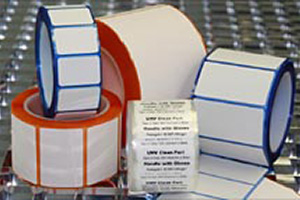Rethinking Pharmaceutical Labeling
By Laura Johnson, Loftware
How a strategic, enterprise approach to labeling can improve regulatory compliance and operational efficiency in the face of industry pressures
For the pharmaceutical industry, the focus is on patient safety and improved patient outcomes. It's also on driving greater efficiencies, cost reductions, and collaboration with contract manufacturers throughout the supply chain. In this environment, labeling is growing in importance, and there are a number of reasons why.

Pressures In The Pharmaceutical Industry
In a world of complexity and regulation, few industries are as complex and regulated as pharmaceuticals. Standards for quality, safety, and procedural accuracy are exceedingly high - as are the stakes - and failure to meet these standards can have profound consequences, including loss of life.
The global nature of the pharmaceutical industry - with worldwide manufacturing and markets - means that regulations are growing around the globe. In addition, the GS1 System of Standards is aimed at improving supply chain efficiencies in numerous industries, including pharmaceuticals, and these standards are continuously evolving.

In the United States, the Food and Drug Administration (FDA) has broad jurisdiction over pharmaceutical shipments crossing U.S. borders, as well as within the country. For the FDA, labeling violations are the easiest violations to find. They require no site inspections, no product testing. Mislabeled shipments - where the label is not correct for a variety of reasons - often result in refusal and/or return of product, as well as hefty customs fines. The FDA also has labeling-related guidelines for GxP for the pharmaceutical industry that should be followed. The Code of Federal Regulations for Electronic Records and Electronic Signatures, or 21 CFR Part 11, has been set forth as guidance for some time, but now the electronics transactional data and eSignatures either are or will be required.
The regulation that is greatly impacting pharmaceutical labeling in the U.S. is Title II of the Drug Quality and Security Act (DQSA), the Drug Supply Chain Security Act (DSCSA). The goal of DSCSA is to create a system that can trace drugs throughout the supply chain so that legitimate products can be verified, illegitimate products detected, and drug product recalls facilitated. Provisions covered under DSCSA cover the full supply chain: manufacturers, wholesaler drug distributers, repackagers, and dispensers. In an ongoing rollout, the following elements will be part of the comprehensive track and trace plan: product identification, tracing, and verification; detection and response; notification; wholesaler licensing; and third-party logistics. All stakeholders will share responsibility for securing the pharmaceutical supply chain to protect providers and patients, and to guard against mishandling of products through counterfeiting, gray marketing, and diversion.
Beyond satisfying regulatory requirements, there are a number of other challenges in the pharmaceutical world - challenges that can be met through better labeling. The pharmaceutical supply chain is highly complex, with many steps, as ingredients are often shipped in bulk, repackaged, and reshipped before they find their way to the manufacturer producing the branded end products. Multiple tiers of wholesalers are often involved. Oftentimes, borders are crossed. Labeling is essential to the smooth flow of the pharmaceutical supply chain, where problems can arise at any juncture in the chain, or may ''wait'' to become manifest only in a finished product.
Additionally, global competition is fierce within the pharmaceutical industry. There are competitive pressures, as well as pressures from healthcare providers and insurers to keep costs from skyrocketing. This results in an increasing focus on maintaining costs and on operational efficiency. This is when the right labeling approach can yield big dividends.
Furthermore, entering new markets is essential for success. This is where many of the opportunities for growth reside. But each new market presents unique challenges and unique labeling needs, as pharmaceutical companies must satisfy local language, shipping, and regulatory demands.
Taking A Strategic Perspective On Labeling
In this world of complexity and regulation, labeling must be viewed from a systemic perspective. Yesterday's approach to labeling, often done on an operational and departmental level, with insufficient strategic planning for organization-wide standards or policies, has resulted in a disparate, piecemeal labeling ''solution'' that's expensive, inefficient, and error-prone. Mislabeled shipments, if the labels aren't corrected within a short period of time, are rejected or languish in customs. Fines may be levied. Lost or faulty product shipments can't be tracked, putting pharmaceutical firms at risk. The labeling requirements of trading partners and customers can't be easily met. Opportunities to reinforce brand are missed.
Today, forward-thinking global pharmaceutical companies increasingly want to look at labeling from a strategic, systemic perspective. They recognize that labeling is a critical mechanism for maintaining compliance, ensuring brand consistency, improving operational efficiency, and supporting business growth. Failure to treat labeling as a strategic process can prove costly. Without a strategic approach to labeling, a pharmaceutical company is likely to experience:
- Excessive Regulatory Costs - Pharmaceutical companies must comply with specific regulatory requirements in each market where their products are sold. New intended uses for a drug must be indicated on labels. This may mean label changes multiple times each year - changes that must be understood, designed, approved, and implemented. Failure to rapidly respond to regulatory changes results in supply disruptions, lost revenue, and customs fines.
- Inefficient Access to Critical Data - Pharmaceutical companies have invested heavily in enterprise-wide business systems. Yet device and packaging labels are often created using disparate processes that aren't integrated automatically to sources of truth residing in key data repositories. The resultant errors, redundancies, inefficiencies, and mislabeling can significantly impact the bottom line.
- Local Labeling Inefficiencies - In today's global supply chains, product design, manufacturing, and packaging processes occur in multiple locations around the world. In the past, label design, control, approval, and printing were driven locally. While localities were able to comply with regional requirements, the variety of labeling solutions and systems that resulted often lacked accuracy and were operationally inefficient. This hampered a manufacturer's ability to meet broader market requirements in a timely manner, increasing the risk of supply chain disruption due to regulatory action. It also meant that when a local labeling system was down, production would shut down as well.
An Enterprise Labeling Approach Promotes Quality And Efficiency
By treating labeling as a strategic process - and by implementing an enterprise labeling solution - pharmaceutical companies are able to achieve consistent branding, reduce regulatory costs, eliminate data redundancy, and improve overall labeling efficiencies. This approach provides a new level of visibility and control for validated label management and pharmaceutical manufacturers can enjoy a wide range of benefits.
Pharmaceutical companies have invested heavily in enterprise systems that contain single sources of truth for managing their business and reporting to regulators. Unlike legacy labeling solutions that maintain off-line data sources (often relying on manual data entry or the use of individual productivity tools like spreadsheets) and increase the risk of mislabeling, an enterprise labeling approach obtains label data directly from single sources of truth, i.e., from key data repositories, ERP systems, and other applications, utilizing business rules in its processes. Data replication and synchronization costs and complexity are reduced or eliminated.
When labeling is integrated with the enterprise business processes, as well as with an existing authoring solution, rather than existing in a stand-alone system, processes are simplified and non-value-added activities are reduced. A true enterprise labeling solution enables operators to perform their value-added manufacturing, packaging, and distribution tasks without having to access separate labeling systems or worry about keeping labeling synchronized with process or operational data. The solution should enable companies to apply business rules to operational data to automatically determine the right label format, content, and device based on the context of the business transaction.
This approach also enables pharmaceutical companies to rapidly respond to changing regional and international regulatory requirements for labeling, including those being established by DSCSA. By leveraging a built-in business rules engine, companies can support labeling variations using configurable rules in a controlled manner, removing the risk of manual errors and mislabeling. Using data-driven label content and configurable business rules provides the flexibility to address requirements quickly while minimizing validation and approval activities necessary to implement those label changes in production.
Also, organizations within the pharmaceutical supply chain are increasingly required to respond to their customer and partner labeling demands. These requirements are varied: logo placement or other branding demands, language variations, location-specific information, country-specific regulations, parts labeling that conforms to a customer's existing systems, labeling that enables healthcare providers to better monitor patient care and help them achieve faster reimbursements, and more. Today, pharmaceutical manufacturers are able to quickly respond to customers' requirements, reducing what was once a month-long process to a matter of a few days.
In the pharmaceutical industry, frequent label changes are a matter of course. New regulations emerge with increasing frequency. Additional intended uses must be reflected in labeling. Mislabeled shipments languish in customs. Entering new markets means accommodating new languages and country-specific rules. Customers or supply chain partners make requests that they'd like to see rapidly met. Branding guidelines are updated. With an enterprise labeling approach, nontechnical business users can quickly make label changes. This both speeds up the labeling process and reduces demand on scarce IT resources.
A Mission-Critical Process Demands A Mission-Critical Solution
Across the pharmaceutical industry landscape, labeling is increasingly recognized as a mission-critical process that helps further an organization's strategic goals. First and foremost: meeting exacting regulatory compliance standards. This means a labeling solution that supports labeling that is GS1, DSCSA, and 21 CFR Part 11 compliant. In addition to offering labeling that helps ensure compliance, a labeling solution should be able to stand up to audit demands.
Beyond regulation, pharmaceutical companies require a labeling solution that's standardized and centralized, and taps into the data and business rules of existing enterprise systems. Such a solution enables organizations to become more operationally efficient - saving on costs, avoiding expensive mistakes, and ensuring that even the most remote facility is in compliance with governmental and industry regulations, while also meeting overall internal branding standards.
About The Author
Laura Johnson is a senior account executive for Loftware. She brings over 20 years of expertise working with both pharmaceutical and medical device manufacturers to improve processes and meet regulatory requirements such as serialization, UDI, and secure supply chain. Laura's career has also focused on the application of technology to drive efficiencies in manufacturing, warehousing, and distribution environments. Her expertise includes leveraging core functionality within major ERP systems like SAP and Oracle, and implementing automatic data capture technologies such as vision inspection, printing, shop floor devices, barcode, and RFID data collection.
For more information on how enterprise labeling can assist your pharmaceutical labeling efforts, download Loftware's Enterprise Labeling Special Report.




